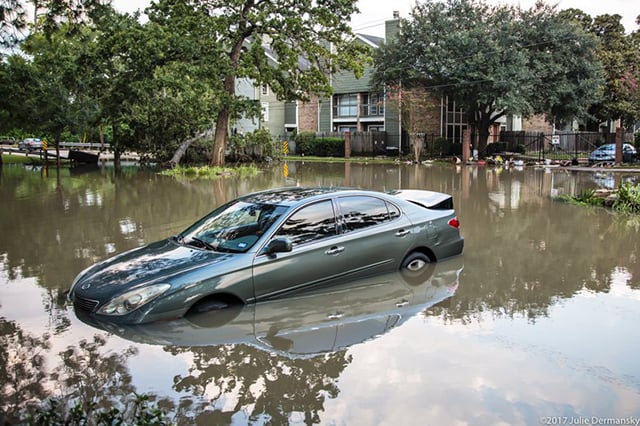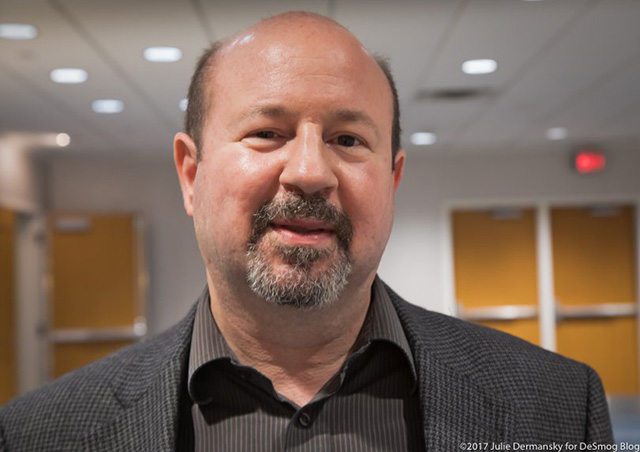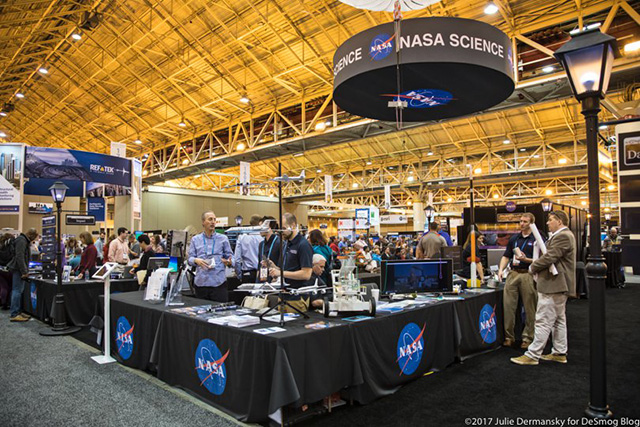
Did you know that Truthout is a nonprofit and independently funded by readers like you? If you value what we do, please support our work with a donation.
The same week that a slew of new scientific reports confirmed just how much humans are changing the climate, and in turn, the rest of the planet, Environmental Protection Agency Chief Scott Pruitt’s plans for a “Red Team, Blue Team” debate of this very same science were put on hold.
The military-style exercise that would falsely pit the overwhelming majority of climate scientists against a handful of non-experts is an eight-year-old talking point of the notorious climate-denying think tank the Heartland Institute (which is likely not surprised by this development). Meanwhile, last week in New Orleans, several groups of prominent climate scientists shared their latest findings at the world’s largest gathering of Earth and planetary scientists. The roughly 25,000 attendees of the American Geophysical Union annual meeting included scientific leaders from academia, government, and the private sector.
Clear and Present Climate Science
These peer-reviewed reports make it clear that any meaningful climate debate in the future should not be over the degree of humanity’s role in climate change, but to what degree the climate has changed already and what can be done to stop it.
The American Meteorological Society’s 2016 “State of the Climate” report offers of extreme weather events not possible in a preindustrial climate. “Climate change was a necessary condition for some of these events in 2016, in order for them to happen,” Jeff Rosenfeld, editor in chief of the Bulletin of the American Metrological Society, said at a press conference. “These are new weather extremes made possible by a new climate. They were impossible in the old climate.”
These included 2016’s record global warmth, extreme heat across Asia, and a marine heat wave off the coast of Alaska, all of which appear in a special report, “Explaining Extreme Events of 2016 from a Climate Perspective.“
Two other scientific reports presented at the conference explain how human-induced climate change intensified Hurricane Harvey’s torrential rain, confirming what scientists suspected.
In one, researchers from Lawrence Berkeley National Laboratory published findings suggesting that Harvey’s rainfall was attributable to global warming, which increased precipitation by at least 19 percent but more likely by as much as 38 percent. Their conclusions came from comparing total rainfall and the chances of a storm of that magnitude under present climate conditions with the likelihood of a similar storm taking place in the 1950s, when the atmosphere had lower levels of greenhouse gases.
 Flooding in the wake of Hurricane Harvey on Briarforest Drive in Houston, Texas. (Photo: Julie Dermansky)
Flooding in the wake of Hurricane Harvey on Briarforest Drive in Houston, Texas. (Photo: Julie Dermansky)
In another report, researchers from the Netherlands published a study examining trends in rainfall intensity along the Gulf Coast starting around 1880 when records begin. They also used multiple global climate change models to determine that global warming made a storm of Harvey’s intensity three times more likely. The Berkeley National Lab study also linked Harvey’s intensity to anthropogenic climate change.
At a press conference on Hurricanes Harvey, Irma, and Maria, Michael Wehner, a senior scientist at the Lawrence Berkeley National Laboratory, and a co-author of the latest study, said, “It is not news that climate change affects extreme precipitation, but our results indicate that the amount is larger than expected.”
The National Oceanic and Atmospheric Administration (NOAA) also presented its annual report on the Arctic, showing that permafrost there is thawing at a faster pace.
“What happens in the Arctic doesn’t stay in the Arctic; it affects the rest of the planet,” acting NOAA chief Timothy Gallaudet said at a press conference when the government report was introduced.
“The Arctic has a huge influence on the world at large,” Vladimir Romanovsky, a professor at the University of Alaska in Fairbanks and co-author of the NOAA study, said. This year’s preliminary reports from the US and Canada showed permafrost temperatures are “again the warmest for all sites” measured in North America.
Jeremy Mathis, head of NOAA’s Arctic research program and study co-author, explained the report’s findings in layman’s terms: “The Arctic has traditionally been the refrigerator to the planet, but the door of the refrigerator has been left open.”
 Scott A. Mandia, founder of the Climate Science Legal Defense Fund, in the American Geophysical Union meeting exhibition hall. (Photo: Julie Dermansky)
Scott A. Mandia, founder of the Climate Science Legal Defense Fund, in the American Geophysical Union meeting exhibition hall. (Photo: Julie Dermansky)
Science, Activism and Action
New to this year’s meeting was the session “Legal Advice for Scientists Interested in Activism.” Lauren Kurtz, an attorney with the Climate Science Legal Defense Fund, offered scientists advice on how to take part in activism and protest without putting their careers on the line. She gave tips that could keep them out of trouble should they choose to protest.
“Interest in the topic has been tenfold since the March for Science in Washington this April,” Kurtz told me.
Basic tips for scientists included not wearing the insignia of their employers when attending an event like the March for Science because it could go against anti-lobbying restrictions or workplace policies. She also advised not using a public university email address for anything connected to political issues because emails are considered government records and could be subject to open records requests and used to try to discredit the scientists, something Penn State atmospheric scientist Michael E. Mann has experienced firsthand.
Everything was not doom and gloom, however. At a session called “Climate Solutions: Policy, Planning, Science and Engineering in Uncertain Political and Economic Times,” climate scientists offered hope that we still have time to curb the worst of climate change if we act now.
Pennsylvania State University professor David W. Titley, who is also a retired naval officer outspoken about climate change threats to national security, pointed out that President Donald Trump signed the National Defense Authorization Act that very day (December 12). This bill requires climate change impacts and threats be taken into account in order to protect US military bases and interests. Despite signing this bill, on December 18, Trump took climate change off the list of national security threats in his new national security strategy.
Dr. Sarah Myhre, a climate researcher at the University of Washington and self-declared proud advocate for science and human rights, brought the “Me Too” movement into the conversation, calling for an end to misogyny in science. She read aloud Trump’s quote about “pussy-grabbing” after pointing out a vacuum of leadership on climate change which she thinks scientists can help fill. “The public is not only looking for information from US The public is looking for cultural leadership,” she explained.
 Climate scientist Dr. Michael E. Mann, known for the famous “hockey stick graph” showing rising modern temperatures, at the 2017 American Geophysical Union conference in New Orleans. (Photo: Julie Dermansky)
Climate scientist Dr. Michael E. Mann, known for the famous “hockey stick graph” showing rising modern temperatures, at the 2017 American Geophysical Union conference in New Orleans. (Photo: Julie Dermansky)
Also on the panel was Michael Mann, who described Pruitt’s proposed “fake Red Team, Blue Team” debate about climate change as a way to undermine the public’s confidence in climate science.
Using a football analogy, Mann warned that if we are going to avert dangerous warming, then the US needs to take an offensive stance, taking the lead on solving the climate problem.
Mann said, “The solutions to this problem are already available and they will lead us down a path of economic prosperity, a clean energy revolution,” and that we can grow our economy while preventing the worst impacts from climate change from happening.
Like Mann, panelist Stefan Rahmstorf of the Potsdam Institute for Climate Impact Research in Germany offered a similar message. Acknowledging changes that have already happened, he insisted that we can still stop the worst of what is coming, but his message of hope came with a dire warning: “We don’t have the time to debate this another three to five years before we do anything because the window of opportunity for limiting global warming to well below two degrees [Celsius] is falling shut on us as we speak.”
 NASA’s exhibit at the 2017 American Geophysical Union Meeting in New Orleans. Some of the items given out by NASA were made in China despite Trump’s “Buy in America” executive order. (Photo: Julie Dermanksy)
NASA’s exhibit at the 2017 American Geophysical Union Meeting in New Orleans. Some of the items given out by NASA were made in China despite Trump’s “Buy in America” executive order. (Photo: Julie Dermanksy)
Press freedom is under attack
As Trump cracks down on political speech, independent media is increasingly necessary.
Truthout produces reporting you won’t see in the mainstream: journalism from the frontlines of global conflict, interviews with grassroots movement leaders, high-quality legal analysis and more.
Our work is possible thanks to reader support. Help Truthout catalyze change and social justice — make a tax-deductible monthly or one-time donation today.